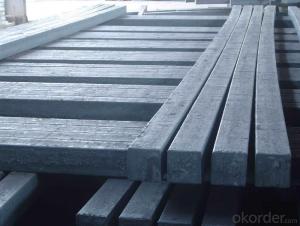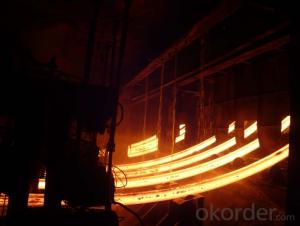Square Steel Billet Q235 3SP Grade Prime Quality 6#
- Loading Port:
- Tianjin
- Payment Terms:
- TT OR LC
- Min Order Qty:
- 2000 m.t
- Supply Capability:
- 50000 m.t/month
OKorder Service Pledge
OKorder Financial Service
You Might Also Like
Description of Square Steel Billet Q235 3SP Grade Prime Quality 6#
M. S. Billets are used for rolling of TMT Re-Bars of Fe415 and Fe500 Grade and various other structural steel products.
CRS Billets are used for rolling of CRS TMT Re-Bars.
Special Alloy Billets are used for rolling of any special grade TMT Re-Bars like Earthquake resistant TMT Re-Bars and for special grade structural steel products.
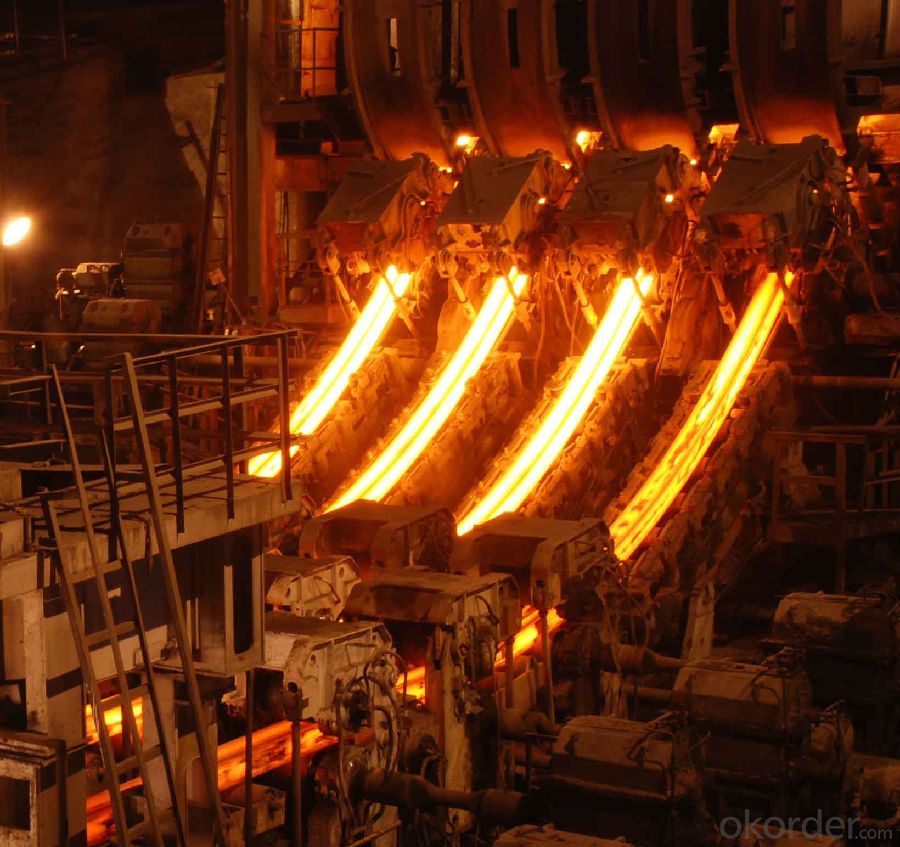
Main Feature Square Steel Billet Q235 3SP Grade Prime Quality 6#
Raw elements(C,Fe,Ni,Mn,Cr,Cu.)---Smelted ingots by AOD finery---hot rolled into black suface---pickling in acid liquid---cold drawn----polished by automatically machine--- cutting into pieces---checking quanlity
Applications of Square Steel Billet Q235 3SP Grade Prime Quality 6#
Widely Used in the areas such as Stainless Steel Fasteners, Chains, Kitchen and Sanitary wares, Furniture handles, Handrails, Electroplating and Electrolyzing pendants, Foods, Electron, Petroleum, Construction and Decoration, etc. Products have a high strength after cold-working. Electronic products parts, Medical appliance, Springs, Bus Inside and Outside packaging and building, Street Lamp Posts, etc. Decoration materials and Outdoor Publicity Billboard. Used for the products which have the Anti-Stress Corrosion requirement. Electron Products, Table-wares, Bolts, Nuts, Screen Meshes, Cumbustors and so on.
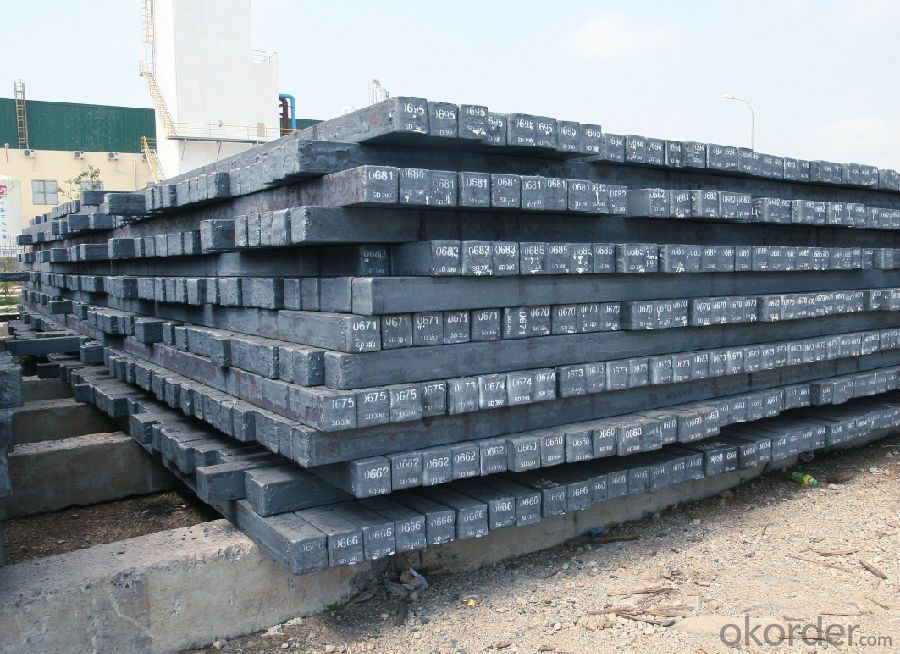
Specifications of Square Steel Billet Q235 3SP Grade Prime Quality 6#
| Standard | C(%) | Mn(%) | S(%) | P(%) | Si(%) |
| Q195 | ≤0.12 | ≤0.50 | ≤0.040 | ≤0.035 | ≤0.30 |
| Q235 | ≤0.20 | ≤1.40 | ≤0.045 | ≤0.045 | ≤0.35 |
| Q275 | ≤0.22 | ≤1.50 | ≤0.045 | ≤0.045 | ≤0.35 |
| 20MnSi | 0.17-0.25 | 1.2-1.6 | ≤ 0.050 | ≤ 0.050 | 0.40-0.80 |
| 3SP | 0.14-0.22 | 0.40-0.85 | ≤ 0.050 | ≤ 0.040 | 0.05-0.15 |
| 5SP | 0.28-0.37 | 0.50-1.00 | ≤ 0.050 | ≤ 0.040 | 0.15-0.30 |
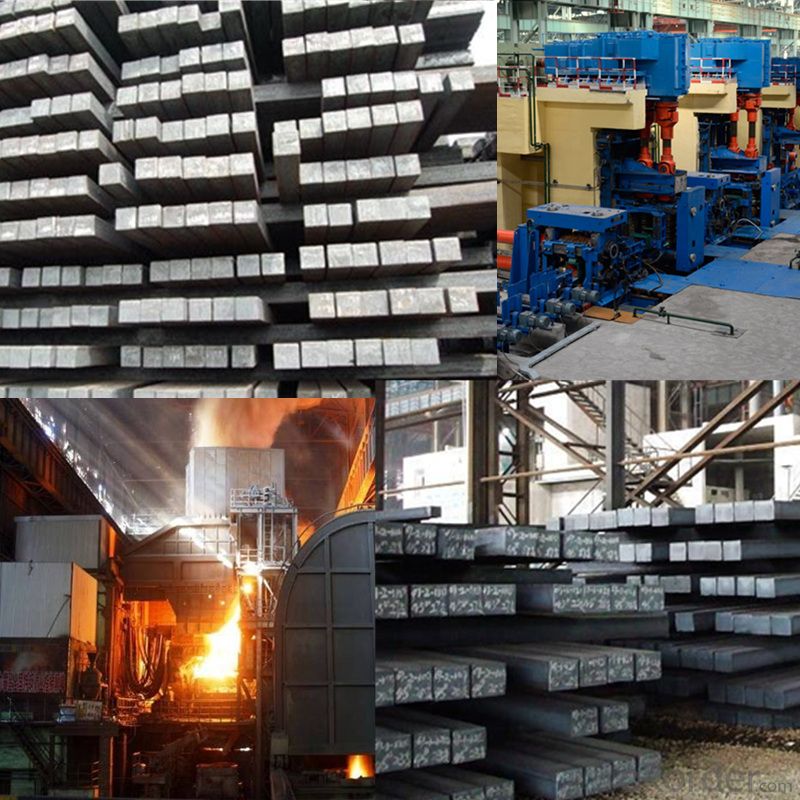
FAQ of Square Steel Billet Q235 3SP Grade Prime Quality 6#
We have organized several common questions for our clients,may help you sincerely:
1. How Can I Visit There?
Our company is located in Tianjin City, China, near Beijing. You can fly to Tianjin Airport Directly. All our clients, from home or aboard, are warmly welcome to visit us!
2. How Can I Get Some Sample?
We are honored to offer you sample.
3. Why choose CNBM?
Our delivery time about 15-20days for standard sizes, if you have other requirements like hardness, quanity and width ,it is about 20-40days. But don't worry we also try our best for the delivery time ,because time longer and our cost is higher.
- Q:Can steel billets be used in the production of consumer electronics?
- No, steel billets are primarily used in the production of construction materials and machinery, rather than consumer electronics which typically require more specialized materials such as semiconductors, plastics, and alloys.
- Q:What are the different types of steel billet reheating furnaces?
- There are several types of steel billet reheating furnaces, including walking beam furnaces, pusher furnaces, rotary hearth furnaces, and roller hearth furnaces. Each type has its own advantages and uses, depending on the specific requirements of the steel production process.
- Q:What are the different types of steel billet handling equipment?
- In the steel production process, a variety of steel billet handling equipment is utilized. These equipment are specifically designed to efficiently transport and move steel billets, which are semi-finished metal products utilized for further processing. 1. Overhead Cranes: Steel mills and foundries often employ overhead cranes for handling and transporting steel billets within their facilities. These cranes possess a high lifting capacity, allowing for seamless movement of billets from one location to another. 2. Mobile Cranes: Offering versatility, mobile cranes can handle steel billets in both indoor and outdoor settings. Equipped with hydraulic systems, these cranes excel at lifting and maneuvering heavy loads. 3. Forklifts: Warehouses and storage facilities frequently rely on forklifts for the handling of steel billets. These machines feature front forks that can be raised or lowered to lift and move the billets. 4. Grab Buckets: Specifically designed for bulk materials, including steel billets, grab buckets feature a bucket-like structure that can be opened and closed to securely grip and release the billets. They are commonly employed at ports and shipping yards for the loading and unloading of billets from ships. 5. Conveyor Systems: Conveyor systems provide continuous movement of steel billets along a predetermined path. They facilitate the transportation of billets between different stages of the production process or for loading and unloading from trucks or trains. 6. Roller Tables: Utilized for transferring steel billets from one conveyor or machine to another, roller tables consist of a series of rollers that allow for smooth and controlled movement of the billets. 7. Magnetic Lifters: Magnetic lifters utilize an electromagnetic field to lift and transport steel billets, making them highly effective for handling ferrous materials. This magnetic force ensures secure gripping and effortless movement. 8. Palletizers: Palletizers are employed to stack and organize steel billets on pallets. Capable of automatically arranging billets in a specific pattern, they are ideal for storage or transportation purposes. Each type of equipment offers unique advantages and is specifically utilized based on the requirements of the steel production process. Factors such as billet size and weight, required transportation distance, and facility-specific needs determine the appropriate handling equipment selection.
- Q:Billet production process
- Two is the steel ingot produced by the steelmaking system or the continuous casting billet processed by the rolling equipment of the steel rolling system, and the three is the semi-finished product processed by the forging equipment of the steel ingot produced by the steelmaking system.
- Q:What is the role of steel billets in the construction of stadiums and arenas?
- Steel billets play a crucial role in the construction of stadiums and arenas as they are the primary raw material used to manufacture structural steel components. These billets are heated and shaped into various forms, such as beams, columns, and trusses, which provide the necessary support and framework for the overall structure. The high strength and durability of steel make it an ideal material to withstand the heavy loads and forces experienced in these large-scale facilities. Additionally, steel billets can be easily fabricated and assembled on-site, ensuring efficient construction and enabling the creation of complex designs and architectural features.
- Q:How do steel billets contribute to the overall strength of a finished product?
- Steel billets are an essential component in the manufacturing process of various steel products, and they play a crucial role in determining the strength of the finished product. The strength of a final steel product is primarily dependent on the quality of the steel billets used. Firstly, steel billets are made by continuously casting molten steel into solid blocks or forms. This process ensures that the steel billets have a consistent and uniform structure, which is vital for maintaining the overall strength of the finished product. The uniformity of the steel billets allows for a more even distribution of stress and load-bearing capacity throughout the final product. Moreover, steel billets are usually made from high-quality steel alloys that are specifically chosen for their superior strength properties. These alloys typically contain elements such as carbon, manganese, and other alloying elements that enhance the overall strength and hardness of the steel. By using high-quality steel billets, manufacturers are able to produce finished products that exhibit excellent tensile and yield strength, making them more resistant to deformation, bending, and breaking. Additionally, steel billets undergo various heat treatment processes, such as quenching and tempering, which further enhance their strength. Quenching involves rapidly cooling the billets to increase their hardness, while tempering reduces the brittleness and improves their toughness. These heat treatment processes result in steel billets with improved mechanical properties, including higher yield strength and improved resistance to fatigue and impact. Furthermore, the size and shape of steel billets also contribute to the overall strength of the finished product. The dimensions of the billets determine the final dimensions of the product, and a larger billet size allows for a more substantial and stronger end product. Similarly, the shape of the billets can be optimized to improve the load-bearing capacity and structural integrity of the finished product. In conclusion, steel billets are critical to the overall strength of a finished product. Through their uniform structure, high-quality alloys, heat treatment processes, and optimized size and shape, steel billets provide the necessary foundation for the production of strong and durable steel products. Selecting the right steel billets and ensuring their quality throughout the manufacturing process are vital steps in creating a finished product with exceptional strength and performance.
- Q:Can steel billets be used for making architectural structures?
- Yes, steel billets can be used for making architectural structures. Steel billets are semi-finished products that are typically cast into specific shapes and sizes before being further processed into different steel products. These billets can be used as a raw material for fabricating various architectural structures such as beams, columns, frames, and trusses. Steel is a widely used material in the construction industry due to its high strength, durability, and versatility. It offers several advantages over other construction materials, including its ability to withstand heavy loads, resist corrosion, and provide excellent fire resistance. Steel billets can be processed and shaped into different forms, allowing architects and engineers to create innovative and complex architectural designs. Furthermore, steel structures offer several benefits in terms of cost-effectiveness, speed of construction, and sustainability. Steel is a highly recyclable material, making it an environmentally friendly choice. The use of steel billets in architectural structures enables the construction of large and complex structures with greater precision and efficiency. Overall, steel billets can be effectively used in the construction of architectural structures, offering numerous advantages in terms of strength, durability, design flexibility, and sustainability.
- Q:How are steel billets used in the manufacturing of hydraulic components?
- Steel billets are an essential raw material in the manufacturing of hydraulic components. Billets are essentially semi-finished forms of steel, typically in a rectangular or square shape, which are further processed into various hydraulic components such as cylinders, pistons, valves, and fittings. The manufacturing process begins with the selection of high-quality steel billets that meet specific mechanical properties and chemical composition requirements. These billets are then heated to a specific temperature to make them more malleable and easier to shape. Once heated, the billets are subjected to a series of mechanical processes such as forging, extrusion, or rolling to transform them into the desired shape and size. For example, in the production of hydraulic cylinders, the heated billets are typically forged or extruded to form the cylinder body. This involves applying intense pressure to the billet, causing it to deform and take on the cylindrical shape. The resulting cylinder body is then further machined to precise tolerances to accommodate internal components such as pistons, seals, and valves. Similarly, hydraulic valves and fittings are also manufactured using steel billets. The billets are machined using various machining techniques such as turning, milling, drilling, and grinding to create the intricate shapes and features required for these components. The final products are then heat-treated or surface-treated to enhance their strength, durability, and corrosion resistance. Steel billets are preferred in the manufacturing of hydraulic components due to their excellent mechanical properties, including high strength, good ductility, and weldability. These properties ensure that the components can withstand high pressures, extreme temperatures, and harsh operating conditions commonly encountered in hydraulic systems. In summary, steel billets are an integral part of the manufacturing process for hydraulic components. They are transformed through various mechanical processes to create the necessary shapes and sizes required for cylinders, pistons, valves, and fittings. The use of steel billets ensures the production of high-quality, reliable hydraulic components that can effectively perform in demanding hydraulic systems.
- Q:How are steel billets used in the production of power transmission equipment?
- Power transmission equipment relies heavily on steel billets, which are indispensable for their production. Gears, shafts, and couplings, vital components of power transmission equipment, necessitate materials that possess both high strength and durability to endure the forces and stresses involved in transmitting power. Steel billets, categorized as semi-finished steel products, play a pivotal role in meeting these requirements. Primarily, steel billets serve as the raw material for forging or casting processes, enabling the creation of diverse power transmission equipment components. Through forging, billets are subjected to high temperatures and shaped under immense pressure, resulting in a robust and compact material with exceptional mechanical properties. On the other hand, casting involves pouring molten steel into molds to form intricate shapes. In this process, steel billets are melted and cast into molds to fabricate complex components like gears or shafts. Moreover, the composition and quality of steel billets are meticulously controlled to ensure the final product aligns with the specific demands of power transmission equipment. Steel billets are manufactured using various steel grades, each possessing distinct properties such as strength, hardness, and wear resistance. The selection of the appropriate steel grade relies on the particular application and operating conditions of the power transmission equipment. For example, a gear employed in heavy-duty industrial machinery may require a higher strength steel billet compared to a gear used in a smaller-scale application. Additionally, steel billets can undergo further processing, such as heat treatment, to enhance their mechanical properties. Heat treatment processes like quenching and tempering have the potential to bolster the hardness, toughness, and overall performance of the billets. This guarantees that the final power transmission equipment possesses the necessary strength and durability to withstand the challenges associated with power transmission. In conclusion, steel billets play a paramount role in the production of power transmission equipment due to their strength, durability, and flexibility. They act as the raw material for forging or casting processes, facilitating the creation of intricate components. Meticulous selection of steel grade and utilization of heat treatment processes ensure that the final product meets the specific requirements of power transmission equipment, solidifying the integral role of steel billets in the manufacturing process.
- Q:How are steel billets used in the manufacturing of springs?
- Steel billets are used in the manufacturing of springs by being heated and then forged or rolled into the desired shape and size. These billets serve as the raw material for producing high-quality springs, providing the necessary strength and durability required for various applications.
1. Manufacturer Overview |
|
|---|---|
| Location | |
| Year Established | |
| Annual Output Value | |
| Main Markets | |
| Company Certifications | |
2. Manufacturer Certificates |
|
|---|---|
| a) Certification Name | |
| Range | |
| Reference | |
| Validity Period | |
3. Manufacturer Capability |
|
|---|---|
| a)Trade Capacity | |
| Nearest Port | |
| Export Percentage | |
| No.of Employees in Trade Department | |
| Language Spoken: | |
| b)Factory Information | |
| Factory Size: | |
| No. of Production Lines | |
| Contract Manufacturing | |
| Product Price Range | |
Send your message to us
Square Steel Billet Q235 3SP Grade Prime Quality 6#
- Loading Port:
- Tianjin
- Payment Terms:
- TT OR LC
- Min Order Qty:
- 2000 m.t
- Supply Capability:
- 50000 m.t/month
OKorder Service Pledge
OKorder Financial Service
Similar products
New products
Hot products
Related keywords


